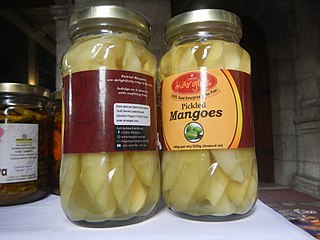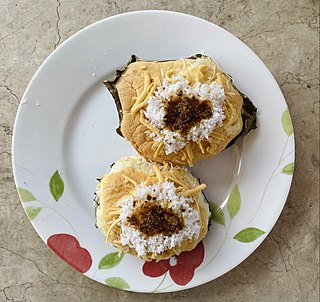
Sushi is a Japanese dish of prepared vinegared rice, usually with some sugar and salt, accompanied by a variety of ingredients, such as seafood—often raw—and vegetables. Styles of sushi and its presentation vary widely, but the one key ingredient is "sushi rice", also referred to as shari (しゃり), or sumeshi (酢飯).

Bagoóng is a Philippine condiment partially or completely made of either fermented fish (bagoóng) or krill or shrimp paste (alamáng) with salt. The fermentation process also produces fish sauce known as patís.

The history of sushi began with paddy fields, where fish was fermented with vinegar, salt and rice, after which the rice was discarded. The earliest form of the dish, today referred to as narezushi, was created in Japan around the Yayoi period. In the Muromachi period (1336–1573), people began to eat the rice as well as the fish. During the Edo period (1603–1867), vinegar rather than fermented rice began to be used. The dish has become a form of food strongly associated with Japanese culture.

Filipino cuisine is composed of the cuisines of more than a hundred distinct ethnolinguistic groups found throughout the Philippine archipelago. A majority of mainstream Filipino dishes that compose Filipino cuisine are from the food traditions of various ethnolinguistic groups and tribes of the archipelago, including the Ilocano, Pangasinan, Kapampangan, Tagalog, Bicolano, Visayan, Chavacano and Maranao ethnolinguistic groups. The dishes associated with these groups evolved over the centuries from a largely indigenous base shared with maritime Southeast Asia with varied influences from Chinese, Spanish and American cuisines, in line with the major waves of influence that had enriched the cultures of the archipelago and adapted using indigenous ingredients to meet local preferences.

Burong mangga is a Filipino side dish made by mixing sugar, salt, and water to mangoes that have previously been salted. The mixture of water and sugar should be boiled and cooled first, before pouring it over the salted mangoes. Some variants add chilis to the cooled sugar water mixture. Original "basic" burong mangga is made using a brine solution and pouring it over halved unripe or partially ripe mangoes. Mango cultivars commonly used for burong mangga include 'Carabao' mangoes and 'Pico' mangoes.

The generic term for condiments in the Filipino cuisine is sawsawan. Unlike sauces in other Southeast Asian regions, most sawsawan are not prepared beforehand, but are assembled on the table according to the preferences of the diner.

Bibingka commonly refers to a type of baked rice cake from the Philippines that is traditionally cooked in a terracotta oven lined with banana leaves and is usually eaten for breakfast or as merienda especially during the Christmas season.

A rice cake may be any kind of food item made from rice that has been shaped, condensed, or otherwise combined into a single object. A wide variety of rice cakes exist in many different cultures in which rice is eaten and are particularly prevalent in Japan. Common variations include cakes made with rice flour, those made from ground rice, and those made from whole grains of rice compressed together or combined with some other binding substance.

Tapai is a traditional fermented preparation of rice or other starchy foods, and is found throughout much of Southeast Asia, especially in Austronesian cultures, and parts of East Asia. It refers to both the alcoholic paste and the alcoholic beverage derived from it. It has a sweet or sour taste and can be eaten as is, as ingredients for traditional recipes, or fermented further to make rice wine. Tapai is traditionally made with white rice or glutinous rice, but can also be made from a variety of carbohydrate sources, including cassava and potatoes. Fermentation is performed by a variety of moulds including Aspergillus oryzae, Rhizopus oryzae, Amylomyces rouxii or Mucor species, and yeasts including Saccharomyces cerevisiae, and Saccharomycopsis fibuliger, Endomycopsis burtonii and others, along with bacteria.

Pla ra, similar to padaek in Laos, is a traditional Thai seasoning produced by fermenting fish with rice bran or roasted rice flour and salt fermented in a closed container for at least six months. Fermented fish seasoning are commonly found in Cambodian, Lao, Mon, Thai and Vietnamese cuisine. Pla ra has a very strong smell, which is considered unpleasant by some people. Its flavors are salty and sour, depending on the amount of salt put in and lactic acid resulting from fermentation process.

Pakhaḷa is an Odia cuisine, consisting of cooked rice washed or lightly fermented in water. The liquid part of the dish is known as Toraṇi. It is popular in the state of Odisha and its similar variants in the eastern regions like Jharkhand, Chhattisgarh, Bengal, and the northeastern states of Assam and Tripura.

Inihaw, also known as sinugba or inasal, are various types of grilled or pit-roasted barbecue dishes from the Philippines. They are usually made from pork or chicken and are served on bamboo skewers or in small cubes with a soy sauce and vinegar-based dip. The term can also refer to any meat or seafood dish cooked and served in a similar way. Inihaw are commonly sold as street food and are eaten with white rice or rice cooked in coconut leaves (pusô). Inihaw is also commonly referred to as Filipino barbecue or (informally) Pinoy BBQ.

Sinangag, also called garlic fried rice or garlic rice, is a Filipino fried rice dish cooked by stir-frying pre-cooked rice with garlic. The rice used is preferably stale, usually leftover cooked rice from the previous day, as it results in rice that is slightly fermented and firmer. It is garnished with toasted garlic, rock salt, black pepper and sometimes chopped scallions. The rice grains are ideally loose and not stuck together.

Sinabawang gulay, usually anglicized as Filipino vegetable soup, is a Filipino vegetable soup made with leafy vegetables and various other vegetables in a broth seasoned with seafood stock or patis. The ingredients of the dish can vary widely. It is eaten on its own or over white rice.
Pangasi, also known as pangase or gasi, are various traditional Filipino rice wines from the Visayas Islands and Mindanao. They could also be made from other native cereals like millet and job's tears. Pangasi and other native Filipino alcoholic beverages made from cereal grains were collectively referred to by the Spanish as pitarrillos.

Pastil, or pastel, is a Filipino packed rice dish made with steamed rice wrapped in banana leaves with dry shredded beef, chicken, or fish. It originates from the Maguindanao people and is a popular, cheap breakfast meal in Mindanao, especially among Muslim Filipinos. Pastil is also known as patil, patel, patir, or pater in Maranao; and paster in Iranun.

Ginataang kalabasa, also known as kalabasa sa gata, is a Filipino vegetable stew made from calabaza in coconut milk and spices. It commonly includes shrimp and yardlong beans and either bagoong or patis. It can also be cooked with fish, crab, or meat and a variety of other ingredients. It is a creamy umami-laden dish that is naturally slightly sweet due to the calabaza. It is a type of ginataan.

Burong isda is a Filipino dish consisting of cooked rice and raw filleted fish fermented with salt and angkak for around a week. The dish is common in central Luzon, most notably in the province of Pampanga. Angkak may also be omitted, especially in western central Luzon, resulting in a white-colored version. Burong isda variants are usually named after the fish they were made with; e.g. burong bangus for burong isda made with bangus (milkfish). Shrimp versions of the dish are known as burong hipon or balao-balao. Burong isda is very similar to other fermented fish and rice dishes of Asia, including narezushi of Japanese cuisine and pla ra of Thai cuisine. All of these dishes rely on lactic acid fermentation to preserve the food.

Balao-balao, also known as burong hipon, is a Filipino condiment of cooked rice and whole raw shrimp fermented with salt and angkak. Once stir-fried, it can be eaten as is with rice or used as a dipping sauce for grilled or fried dishes. Depending on the salt content, it is fermented for several days to weeks. The lactobacilli involved in the fermentation process of the rice produces lactic acid which preserves and softens the shrimp.



















